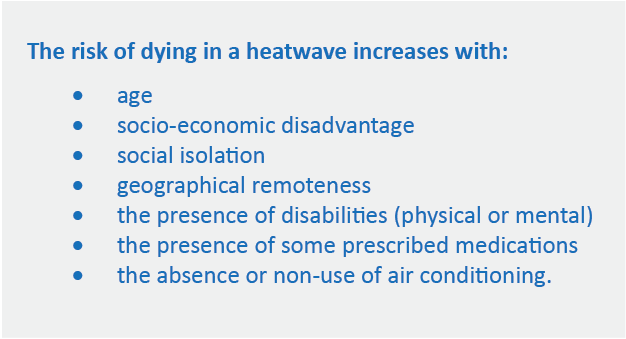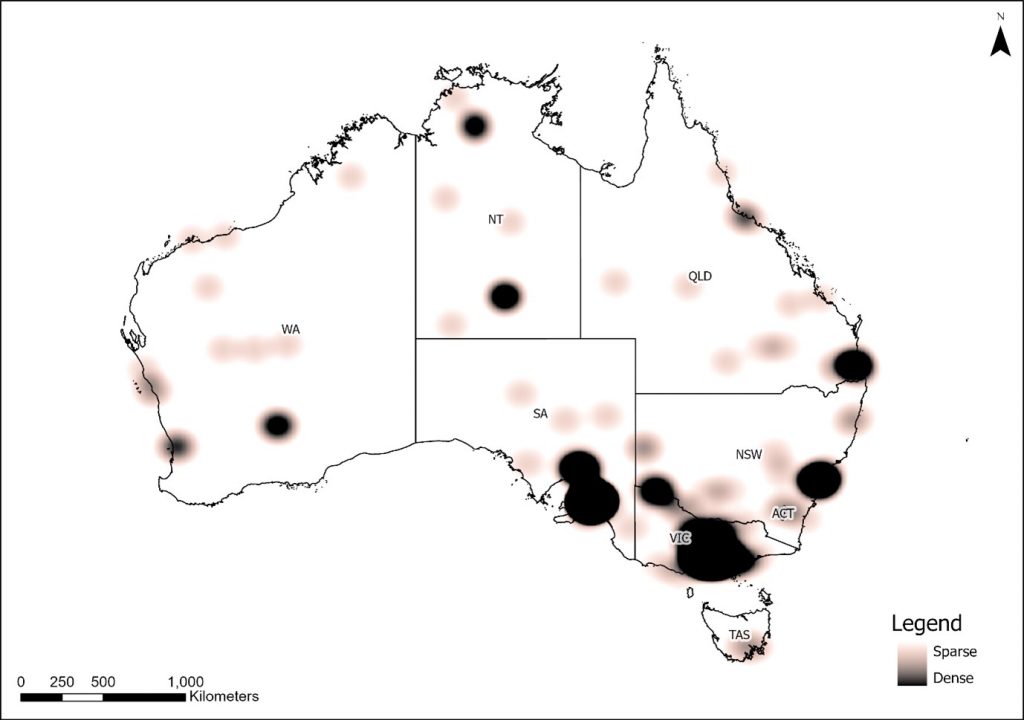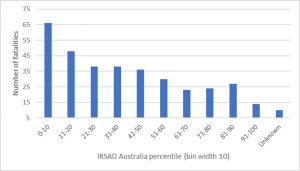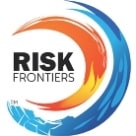Heatwave fatalities in Australia: a new analysis
- Newsletter Volume 20, Issue 3 - Article 1

The new work (Coates et al, 2021) analyses statistics of fatalities associated with extreme heat in Australia from 2001-2018, as identified by a Coroner: the first longitudinal study of heat-related deaths utilising coronial records in Australia. The detail in coronial reports, including demographic information on the decedent and contextual details on the nature of the fatality, enables a better understanding of circumstances around such fatalities.
Heatwaves are recognised as one of the key natural hazard risks to human health. They have increased in frequency and intensity in recent decades, a trend projected to continue under most future climate scenarios (e.g., Perkins-Kirkpatrick et al, 2016). This, in combination with Australia’s population growth, greater urbanisation and an aging population – with the elderly more likely to experience poor health and to be living alone with fewer social contacts and limited finances – places an increased importance on research-based risk reduction strategies.
Method
Defining a heatwave can be tricky. This study employed one of the most widely used metrics for the definition of heatwaves: the Excess Heat Factor (EHF), which is the basis for the Bureau of Meteorology heatwave warning system (Nairn and Fawcett, 2015). The EHF index identifies conditions significantly hotter than usual and is location-specific – see Coates et al (2021) for details of the methodology and the definitions of heat-related and heatwave fatalities used.
Assigning deaths can also be tricky. Heat-associated deaths are generally not well documented; heat often contributes to death without being the direct cause and heat may not be considered as a potential cause of death. With respect to coronial records, it is not generally possible to identify heat-related deaths through autopsy alone: the circumstances around the death must also be understood. Thus, many deaths that are in fact heat-related will not necessarily be recorded as such.
Our research was based on closed case records1 from 1 July 2000 to 30 June 2018 (i.e., financial years FY2001-FY2018) from the National Coronial Information System (NCIS) database. NCIS maintains a secure online database storing deaths reported to a coroner from all Australian jurisdictions beginning July 2000 (Queensland from January 2001) and New Zealand beginning July 2007. Due to the sensitive nature of the data, ethics approvals were obtained from the human research ethics committees of Australia’s jurisdictions.
Raw numbers of fatalities were normalised by viewing the fatality numbers against a background population of the particular group of interest. Normalisation enables the comparison of fatalities over time and across jurisdictions by taking into account any changes in population over time and population differences from place to place.
Limitations other than those mentioned included the relatively large proportion of coronial cases in the more recent years of record that were unavailable for viewing, and the fact that data available for analysis in accessed coronial files was limited due to differences in recording data over time and between jurisdictions, meaning that data presented may represent a lower bound.
Results
At least 473 heat-related deaths were reported to a coroner in Australia in the 18 years from July 2000 to June 2018, 354 occurred during heatwave conditions, as defined by Nairn and Fawcett (2015) and, of these, 244 occurred within or near buildings. There was no overall trend in the number or rate of fatalities, but a record of generally low numbers is interspersed with periodic excursions into very high numbers. Unless otherwise indicated, statistics below refer to the 354 heatwave fatalities.
The locations of heatwave fatalities are shown in Figure 1. Areal hotspots occurred mainly in the coastal capitals, especially in south-eastern Australia.

Half of the heatwave fatalities occurred in Victoria (VIC), and a quarter in South Australia (SA). Just two heatwave events – in 2009 and 2014, across VIC and SA – accounted for almost two-thirds (63%) of the total fatalities and 82% of building-related fatalities. Considering population statistics and utilising annual average fatality rates, the Northern Territory (NT) and SA had the highest fatality rates – 0.32 and 0.31 deaths per 100,000 population respectively – followed by VIC (0.18). All other jurisdictions were below the national average of 0.09.
Data available on cooling sources were limited. No type of air conditioning was present in most of the 50% of cases for which air conditioner ownership was known. In 4% of cases, air conditioning was known to be present and functional but not in use. In at least seven of these cases, data within police and/ or Coroner’s reports stated that the deceased had a habit of not using air conditioning. Importantly, of the cases for which it was known if any type of air conditioning was present, it was not present for 81% of fatalities. This contrasts with the 26% of households in Australia reported as not having air conditioning.
Some 63% of fatalities were male, although this differed across individual years: e.g., 55% in FY2009 but 63% in FY2014 – the two extreme heatwave years. Figure 2 shows the number of male and female fatalities and the fatality rates, which also peaked in FY2009 and FY2014.

Note: in more recent years, less NCIS cases were closed and thus available for analysis
Note: The y-axis has been set to a minimum value of five to exclude any values <5, as requested by NCIS
In general, the most deaths per five-year age category occurred in those aged 50 years and above (Figure 3); notably in the 85+ and 75-79 age categories. Some 243 (69% of) fatalities occurred in the 60-plus age group; of the 244 fatalities that occurred indoors, 80% occurred in this group.

Note: The y-axis has been set to a minimum value of five, as requested by NCIS. There were <5 fatalities in the 0-4 to 15-19 groups and nil fatalities in the 20-24 group
The vulnerability of older Australians to heatwaves is further shown in Figure 3 by the fatality rate (calculated as the average annual fatality rate per 100,000 people for each of the 5-year age groups), which stepped up slightly for the 50-54 and 55-59 age groups, again for the 60-64 to 70-74 age groups, more sharply to approximately 0.46 deaths per 100,000 population for the 75-79 and 80-84 age groups and then to 0.83 for those aged 85-plus.
A low SEIFA/ IRSAD index score2 indicates lack of advantage and relatively greater disadvantage, and a high score indicates greater advantage and a relative lack of disadvantage. Use of the IRSAD index clearly showed that more deaths occurred amongst those locations showing the greatest socio-economic disadvantage and least socio-economic advantage. Some 64% of fatalities occurred in the top 50% most socio-economically disadvantaged areas and 32% in the top 20% most socio-economically disadvantaged areas (Figure 4).

Data source: ABS 2016a. Socio-economic disadvantage decreases to the right of the x-axis: 0-10 is most disadvantaged and 91-100 is least disadvantaged.
Most commonly, decedents were carrying out “business as usual” (48%), with no precautions taken in at least 38 cases and some precautions taken in at least 18 cases. The next most common behaviours were no/ limited action (11%) and attempting to cool themselves without leaving the building (11%). Other behaviours which may have contributed to heat-related deaths included a lack of air circulation, exercising or strenuous activity in the heat, living in squalor, refusing assistance and/ or medications or not using home air conditioning.
Discussion
We found that heatwaves still pose a greater threat to Australian mortality than any other natural hazard. Australia has no national heatwave risk management framework, although groundwork has been laid by many of Australia’s jurisdictions. Heatwaves are a complex hazard and thus an integrated, collaborative management approach, consisting of risk assessment, care for vulnerable people, urban planning, landscape management, emergency and recovery planning, community awareness and resilience and organisation and business resilience, is necessary.
Our results are in accord with other Australian and international studies: those more likely to die in heatwave events are the elderly, young children, people with existing medical conditions and/ or disabilities, the isolated, and people who experience social and financial disadvantage. An added difficulty is that those most vulnerable to heatwaves are generally also vulnerable to other risks in society and are often overlooked or difficult to access.
Our study results emphasises the importance of retrofitting existing housing stock in order to better cater for the greater proportion of the elderly who use them as refuge. The implementation of targeted awareness campaigns with a particular focus on those who are older and/ or socially or geographically isolated, socio-economically disadvantaged or living with a disability – as a partnership between local councils, public health authorities, general practitioners, pharmacies, community organisations and public/ social housing providers – could improve these conditions.
Acknowledgements
The other paper authors were: Jonathan van Leeuwen, Stuart Browning, Andrew Gissing, Jennifer Bratchell and Ashley Avci. This work could not have proceeded without the approval of the Macquarie University Human Research Ethics Committee, the Victorian Department of Justice Human Research Ethics Committee, the Coroners Court of Victoria Research Committee and the Western Australian Coronial Ethics Committee. Our sincere thanks go to the National Coronial Information System (NCIS) for their valued resource of coronial records and for their assistance throughout the project, especially to Jessica Bryan, and to the Victorian Department of Justice and Community Safety, who manage the NCIS. This work was supported by the Australian Building Codes Board and Macquarie University.
References
Coates, L., Haynes, K., O’Brien, J., McAneney, J., Dimer de Oliveira, F., Exploring 167 years of vulnerability: An examination of extreme heat events in Australia 1844-2010, Environ Sci Policy, 2014, 42, 33-44, http://www.sciencedirect.com/science/article/pii/S1462901114000999.
Coates, L., van Leeuwen, J., Browning, S., Gissing, A., Bratchell, J., Avci, A., 2021, Heatwave fatalities in Australia, 2001-2018: an analysis of coronial records. Int J Dis Risk Red 67 (Jan 2022) https://doi.org/10.1016/j.ijdrr.2021.102671
Nairn, J., Fawcett, R., The Excess Heat Factor: A metric for heatwave intensity and its use in classifying heatwave severity. Int J Environ Res Pub Health, 2015, 12, 227-253.
Perkins-Kirkpatrick, S.E., White, C.J., Alexander L.V., et al, Natural hazards in Australia: heatwaves. Climatic Change, 2016, 139, 101–114, https://doi.org/10.1007/s10584-016-1650-0
1 Closed cases are those finalised (i.e., investigations are no longer open) and thus available for viewing
2The Socio-Economic Indexes for Areas (SEIFA) data product, derived from the ABS five-yearly Census of Population and Housing, enables the assessment of the relative welfare of Australian communities. The Index of Relative Socio-economic Advantage and Disadvantage (IRSAD), created from 2016 census data to summarise socio-economic conditions within defined areas, is used when the topic being analysed is likely to be affected by both advantage and disadvantage
About the author/s

Lucinda Coates
Lucinda is a Senior Research Consultant at Risk Frontiers. With over 30 years in the natural hazards field, she specialises in the impacts of and vulnerability vs resilience to hazard events. Highly experienced in data analysis, Lucinda also manages PerilAUS, an Australian database of hazard impacts.

Jonathan Van Leeuwen
Jonathan is a Research Analyst at Risk Frontiers. He has a BSc(Spatial Information Science) and engages with government, private sector and not-for-profit clients to provide physical and social research, data analysis and GIS solutions for natural hazard related risk management and resilience.

Stuart Browning
Stuart is Risk Frontiers' Climate Risk Scientist, with extensive experience studying the weather and climate in Australian and the Asia-Pacific region. His focus is to understand the large-scale climatic drivers of extreme weather events to better quantify risk over seasonal to multi-decadal timescales, using reanalysis data, model simulations, and paleoclimate records.
